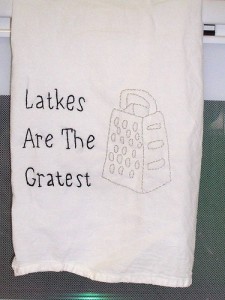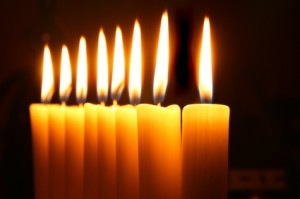 Not a fritter and not a flat dough circle hot off the griddle, a latke — commonly called a potato pancake — is traditionally made from potatoes, grated onions, and some form or combination of binders like eggs, flour, and matzoh meal. The potatoes aren’t the fancy kind. Russets (Idaho potatoes) are commonly used because they brown well and have a high starch content which sops up moisture making for a tender interior.
Not a fritter and not a flat dough circle hot off the griddle, a latke — commonly called a potato pancake — is traditionally made from potatoes, grated onions, and some form or combination of binders like eggs, flour, and matzoh meal. The potatoes aren’t the fancy kind. Russets (Idaho potatoes) are commonly used because they brown well and have a high starch content which sops up moisture making for a tender interior.
Potato pancakes are common in many parts of the world. Why not – they’re easy and inexpensive to make using locally grown vegetables, especially ones that store well like potatoes.
Potato pancakes of all kinds are often flavored with garlic or other seasonings, then shallow-fried in oil in a pan. Some are made with sweet potatoes, other vegetables, chickpeas, cheese, or whatever else the cook wants to add – and how far he or she wishes to fly in the face of tradition.
Hanukkah Food
Latkes, a Yiddish derivation from the Ukrainian word (oldka) that translates to pancake or fritter, are a favorite Hanukkah food. The Ukranian word is a diminutive of an Old Russian word (olad’ya) that stems way back to elaia, the Ancient Greek word for “olive.” Fast forward many centuries and about five languages and latkes are “little tiny things made of (olive) oil.”
Hanukkah (or Chanukah), the Festival of Lights, is an eight-day Jewish celebration that commemorates the second century BC victory of the Maccabees over the Syrians. After the victory Judah called on his followers to cleanse the Second Temple, rebuild its altar, and light its menorah, the gold candelabrum with seven branches representing knowledge and creation.
The Temple needed to be rededicated by lighting the eternal light present in every Jewish house of worship — which shouldn’t be extinguished once lit. There was only one pitcher of untainted sacramental oil, barely enough to burn for one day, but miraculously, the small amount of oil continued to burn for eight days and eight nights.
Fried foods like latkes (also called levivot) and soofganiyot (donuts) are eaten on Hanukkah because they are cooked in oil, a reminder of the miracle of the single pitcher of oil in The Temple, which lasted for eight days instead of one.
Want Crisp — Not Soggy — Latkes?
Latkes should have a deeply browned crust with lacy edges. They don’t have smooth and mashed-potato-like insides – they’re made from shredded or grated potatoes, not mashed. Potatoes and onions, especially when they’re grated, ooze moisture, so they and other ingredients need to be dried with paper towels or have the moisture squeezed out before frying or they’ll be soggy.
- Oil doesn’t go into the latkes, but since they’re fried, it’s an essential ingredient. Don’t skimp on the amount you put into the frying pan. You need enough so the latkes will cook evenly. If you use too little, the outsides get too dark before the insides are cooked through. Olive oil might have too low a smoke point for latke frying, so use another kind of oil like canola, grapeseed, or peanut – all of which have high enough smoke points.
- Oil that isn’t hot enough seeps into food and makes it greasy. If you add oil to the pan when you’ve got batter in it, the oil probably isn’t going to be hot enough. Wait for the oil to get hot enough before adding the food – you’ll end up needing to add little, if any, to finish an entire batch. Test to see if the oil is hot enough by dropping a bit of batter into the pan. If it sizzles and the batter rises to the surface, the oil is hot enough and you’ll end up with crispy, but not greasy, latkes.
- When you drop the batter into the oil, don’t crowd the pan or you’ll bring down the temperature of the oil. The latkes will be tough to turn and without space they might form one giant pancake.
- Leave them alone until they get a nice golden crust on the bottom. They’re ready when both sides are deep brown and crusty. They darken as they cool so be careful that they’re not too dark — verging on burned. Remove each latke with two forks or a slotted spatula and fork, briefly holding it vertically over the frying pan to drip. Put them on layers of paper towels, which will sop up any extra oil.
For more hints and tips about holiday eating get my book, The Sensible Holiday Eating Guide: How To Enjoy Your Favorite Foods Without Gaining Weight, available from Amazon for your kindle or kindle reader.

